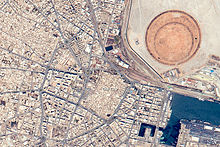Phosphogypsum

Phosphogypsum is the calcium sulfate hydrate formed as a by-product of the production of fertilizer from phosphate rock. It is mainly composed of gypsum (CaSO4·2H2O). Although gypsum is a widely used material in the construction industry, phosphogypsum is usually not used, but is stored indefinitely because of its weak radioactivity caused by the presence of naturally occurring uranium and thorium, and their daughter isotopes radium, radon and polonium. The long-range storage of phosphogypsum is controversial.[1] About five tons of phosphogypsum are generated per ton of phosphoric acid production. Annually, the estimated generation of phosphogypsum worldwide is 100 to 280 Mt.[2]

Production[]
Phosphogypsum is a by-product from the production of phosphoric acid by treating phosphate ore (apatite) with sulfuric acid according to the following reaction:
- Ca5(PO4)3X + 5 H2SO4 + 10 H2O → 3 H3PO4 + 5 (CaSO4 · 2 H2O) + HX
- where X may include OH, F, Cl, or Br
Phosphogypsum is radioactive due to the presence of naturally occurring uranium and thorium, and their daughter isotopes radium, radon, polonium, etc. Marine-deposited phosphate typically has a higher level of radioactivity than igneous phosphate deposits, because uranium is present in seawater. Other components of phosphogypsum are cadmium (5–28 ppm), fluoride (ca 1%), and silica.[2]
In the United States[]

The United States Environmental Protection Agency (EPA) has banned most applications of phosphogypsum having a 226Ra concentration of greater than 10 picocurie/gram (0.4 Bq/g).[5] As a result, phosphogypsum which exceeds this limit is stored in large stacks.
Central Florida has a large quantity of phosphate deposits, particularly in the Bone Valley region. The marine-deposited phosphate ore from central Florida is weakly radioactive, and as such, the phosphogypsum by-product (in which the radionuclides are somewhat concentrated) is too radioactive to be used for most applications. As a result, there are about a billion tons of phosphogypsum stacked in 25 stacks in Florida (22 are in central Florida) and about 30 million additional tons are generated each year.[6]
Various applications have been proposed for using phosphogypsum, including using it as material for:[1]
- Artificial reefs and oyster beds
- Cover for landfills
- Road pavement
- Roof tiles
- Soil conditioner
EPA approved the use of phosphogypsum for road construction in 2020, saying that the approval came at the request of The Fertilizer Institute, which advocates for the fertilizer industry.[7] Environmentalists opposed the decision, saying that using the radioactive material in this way can pose health risks.[8] In 2021, the EPA withdrew the rule authorizing the use of phosphogypsum in road construction.[9]
See also[]
- Red mud, a comparable waste product, but from aluminum processing
References[]
- ^ a b Ayres, R. U., Holmberg, J., Andersson, B., "Materials and the Global environment: Waste Mining in the 21st Century", MRS Bull. 2001, 26, 477. doi:10.1557/mrs2001.119
- ^ a b Tayibi, Hanan; Choura, Mohamed; López, Félix A.; Alguacil, Francisco J.; López-Delgado, Aurora (2009). "Environmental Impact and Management of Phosphogypsum". Journal of Environmental Management. 90: 2377–2386. doi:10.1016/j.jenvman.2009.03.007. hdl:10261/45241. PMID 19406560.
- ^ Stéphanie Wenger, « Tunisie : comment Sfax veut récupérer « sa » mer », La Tribune, 29 juillet 2013
- ^ "Imminent Failure of Phosphogypsum Stack in Tampa Bay Exposes Phosphate Industry Risks". Tucson, AZ: Center for Biological Diversity. April 3, 2021.
- ^ United States Environmental Protection Agency (EPA) (1992). "Subpart R - National Emission Standards for Radon Emissions From Phosphogypsum Stacks." Code of Federal Regulations, 40 CFR 61
- ^ Florida Institute of Phosphate Research. "Phosphogypsum and the EPA Ban" Archived February 19, 2015.
- ^ "EPA Approves Use of Phosphogypsum in Road Construction" (Press release). EPA. 2020-10-14. Archived from the original on 2021-03-18.
- ^ Frazin, Rachel (2020-10-15). "EPA allows use of radioactive material in some road construction". The Hill.
- ^ Budryk, Zack (July 2, 2021). "EPA withdraws rule allowing use of radioactive material in road construction". The Hill. Archived from the original on July 3, 2021. Retrieved July 4, 2021.
- Radioactive waste
- Sulfates
 WikiMiniAtlas
WikiMiniAtlas